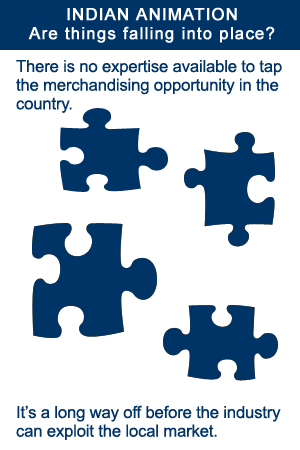 The true thrill of animation lies in creating original films. However, the term Indian animation industry denotes something more voluminous than a few boutique studios. These few studios doing original work cannot collectively be termed as an industry. A major part of the Indian animation industry comprises of sweatshops which do contracted production work for International clients.
The true thrill of animation lies in creating original films. However, the term Indian animation industry denotes something more voluminous than a few boutique studios. These few studios doing original work cannot collectively be termed as an industry. A major part of the Indian animation industry comprises of sweatshops which do contracted production work for International clients.
There are 2-3 business models prevalent in this nascent industry in India.
Model A is the services model. The studios that follow this business model pitch their services to international clients and plank it on low cost and India’s IT success story. They also cite english speaking workforce as an additional USP.
Model B is the boutique studio model. The studios that take this up as their business model pride on their ingenuity and originality. They come up with brilliant animation and story telling and most often create animation for commercials.
Model C is the co production model. Studios that have been doing service work for a while have now graduated to this model where they put in their equity in form of sweat. This means that if the property that they are working on works, they make a share of the profits.
The above mentioned models are stated in a simplified manner. However each studio in a bid to play to its individual strengths modifies and combines the above 3 models to come up with their own business model.
As one pans across the length and breadth of the country, profiling studios, studying their business models, one witnesses the struggle and strife to find the perfect business model.
The studios are struggling to find their feet. The same strife is reflected at the MACRO level. The industry is trying to find its voice. A great many questions surface at this juncture…
Tonnes of questions, all with the objective of achieving success and revenues.
The BPO perspective
The BPO and IT/ITES industries look at each assignment in terms of headcounts, delivery dates and size of the assignment. How many man-hours? How many jobs generated? How much revenue? For these, be it an animation project or a medical packaging design project, or a credit card customer response assignment the attitude and approach in which they deal with the project does not change.
The Boutique shops
On the other extreme are the boutique shops. These are manned by creative and artistically inclined people. Their motivation is the next project or sometimes even the next frame that they are to animate. Business models, process driven pipelines, large assignments, contract work and such, hold no charm for them.
Taking shade under the ITes umbrella makes sense for now, but…
India has made a big name and has been a leader when it comes to the ITes/BPO industries. Taking shade under this umbrella makes quite a lot of sense for animation companies. There are the tax breaks, the lobbying, the good reputation etc. However, there are a few things that ought to be kept in mind. Processes, structures, pipelines are all very useful to optimize output, but finally in animation it is the quality of the output that matters.
Quality, Quality, Quality…
Keeping aside the topic of IP creation, even when it comes to contracted production work, the quality of animation matters a lot. Animation well executed means that the client will have a better run of his show and in turn come back with more projects. A case in point is the animation for Jakers, which Crest Animation did for the producer. Associating with a successful show even if a studio has done contract work for it, assuredly gets in more business.
The processes, the assembly lines, the BPO mindset and HR rules have to be modified and structured not to just optimize output and exceed billings, but to be conducive to good quality animation. Whether it be original IP or service work, the Indian animation industry will grow and achieve success only if it strives to better the quality.
Human Resource Management, ERP
Just as the mindset of an MBA is different from that of a programmer or code developer, the mindset of an animator is far different. If the ITes companies invest into animation , they cannot apply the same HR and ERP parameters for artists. Artists require a lot of space and freedom, they treat work as religon but wouldn’t like to be dictated work timings and the like. If the management of a studio were to lure artists only by offering top dollars, they would be getting mercenaries whose quality of work wouldn’t manage to appeal to audiences.
While creating assembly lines and production pipelines becomes difficult if one has to give in to the whims and fancies of an artist, it has to be remembered that these are the demands of this field and only those that have the talent to manage, should enter. A helpful hint here is, the more the artists are personally involved in the project, the easier it becomes to implement and execute.
Besides, there are very few creative people in the Indian animation industry. The rest are part of it more so because of the need for a decent salary. These potential artists have to be given some space, they have to be given exposure to more than just what it takes to increase their output. They have to be exposed to various areas of animation film making, thereby activating in their minds a certain enthusiasm to better their work and to aspire to create original work.
 Succesfull exploitation of IP?
Succesfull exploitation of IP?
Original ideas and IP can only be exploited and profited from when they can be successfully implemented and executed. Whereas there is no dearth of enthusiastic ideators, they have to bear in mind the reality that there are few people out here to help execute. Success in the festival circuits is good, but that success is different from the commercial success that is achieved when a character or a series gets high ratings and opens the door for licensing and Merchandising activities.
Even as the Industry keeps itself afloat and nurtures itself on contracted work, there have to be collaborative efforts in setting up mechanisms and systems to help analyze and research the merchandising potential in the country. Domain expertise has to be developed in marketing, pricing, packaging, promoting of animation and animation related products such as toys, games, comics and other merchandise.
Looking into the near future, the industry would do better, if for now they stayed with the IT/ITES umbrella because of the largesse and power that the segment enjoys, but there has to be quite a lot of modification in the way processes and systems are set up.
For the creative boutique studios, they need to develop their own marketing divisions and look beyond than just doing commercials. Setting up a service work division and pitching for venture capital based on the service work, could help them develop the financial and infrastructural muscle that they badly need, in order to realize their dreams of creating features and their own stories.
And hopefully some day, we shall have our own Pixars, Our own ILMs, Our own Wild Brains!
Read previous Animation ‘xpress editorial ‘The Mystery’ (Published 23 August ’04)